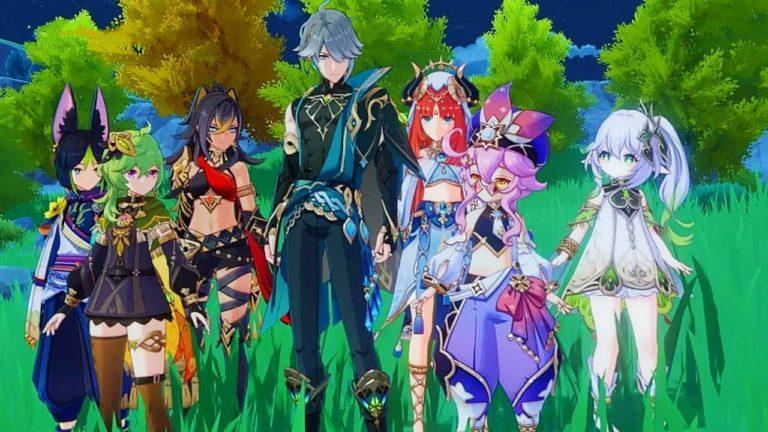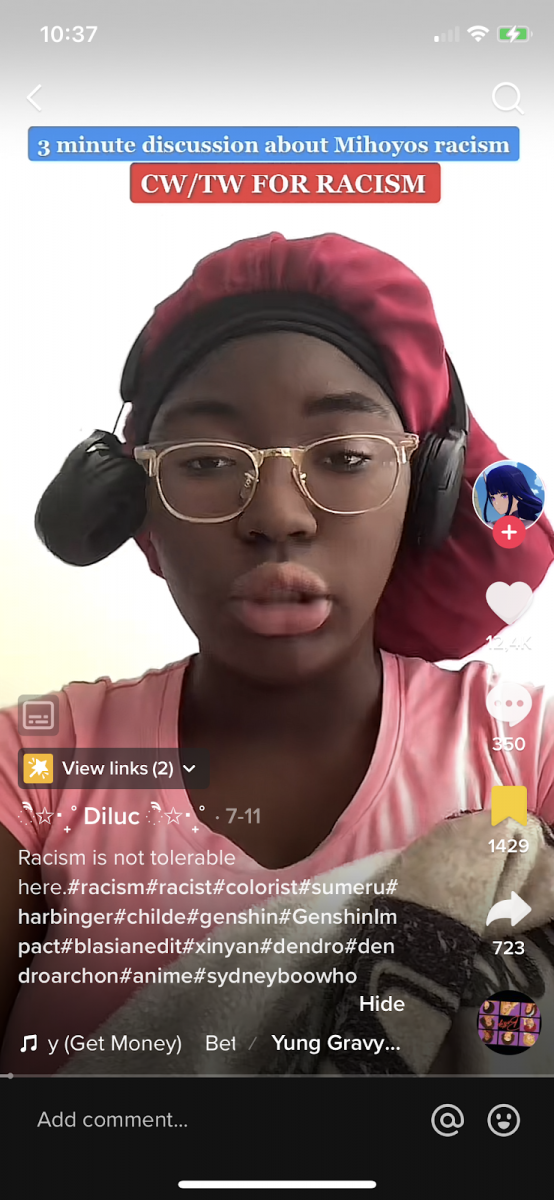
Representation in Genshin Impact: Can Fantasy be Racist?
Genshin Impact, a game created by the Chinese company Hoyoverse, has been quickly rising to fame among gamers worldwide. This quick success can be attributed to the game's accessibility - it can be downloaded for free on almost any gaming device, from a PC or gaming console to a mobile phone. With gaming becoming a popular hobby in recent years, thanks to said accessibility, Genshin Impact has gathered a diverse audience from all around the globe. However, recently the game has been facing accusations of racism.
What is Genshin Impact and what does it have to do with representation?
The plot of the game is built on exploring the diverse nations of a fictional world called Teyvat, each of the nations based on real regions - different parts of Europe, Asia, Africa, and the Americas. The most recent quests to come out have been connected to the nation of Sumeru, which combines in itself elements of South East Asia and North Africa (further, SWANA). As the designs of new characters have first been shared on the game’s social media (Figure 1), the fandom engaged in heated debates on the topic of accurate representation. These characters have been deemed too pale for the region they are supposed to represent, with some players accusing the game company of racism and white-washing. The other side of the discourse claimed that skin tone should not matter in a fantasy game and, moreover, that the race of the character does not affect the quality of the game in the slightest. This led me to wonder if accurate representation in games has an influence on the public and whether it would really be important even for a “fantasy” game about made-up nations. This paper will look at player interactions to answer the question: why is accurate representation important in fiction?

Figure 1. The Sumeru characters revealed with the release of the new region.
User interactions and the meaning behind them
To look further into the questions that this particular discourse raised, it would be most logical to apply ethnomethodological practices in the analysis of the gathered data and look into intertextuality within the issue. Ethnomethodology, as defined by Garfinkel (1974), studies how people create and apply meaning to different phenomena through social interactions. Intertextuality determines how different texts are interdependent in shaping and influencing one another, as every text is formed through a variety of qualities from other texts (Nordquist, 2020).
Observing how players interact with parts of the game such as character design in online spaces would then demonstrate whether racial representation is an important factor when determining the impact the game has on them. Looking at interactions that players have with content regarding the topic of racism in-game, as well as paying attention to their way of interaction and argumentation of their stance - through hashtags, keywords, framing - as propositioned in Blommaerts’ essays on Garfinkel (2019), will show the social structures with the community and, thus, the overall effects underrepresentation has on the community. Further looking into how misrepresentation in the game is affected by the long-standing oppressive narratives within the media would show what and how is used to create the discourse in the first place, and see the consequences of racial exclusion in different mediums.
For this study, I explored hashtag combinations of #Genshin and #Sumeru on TikTok to look into who uses those hashtags, what kinds of content those users make regarding the topic, and see in what way they interact with the overall issue of lack of diversity - how they tie it in with the global issues of racism, colorism, and stereotyping.
The issue in the eyes of players
One type of content which is prevalent under the aforementioned hashtags is the users who compare the most recent instances of misrepresentation in Genshin Impact to the company’s overall history with accusations of racism (Figure 2). In one post, the user @12.5q is pointing out how negative stereotyping is applied to the characters who appear to be people of color (further, POC). Such interactions are what create meaning in ethnomethodology, as instead of assuming what effect misrepresentation has on the community spaces, we see the exact actions of players and the meaning behind them.
In this example, the user connects the racist implications of the non-playable dark skin characters Sumeru all being antagonists - enemies who the main character has to fight - to how a previously released playable dark skin character in the game is described as scary and annoying to the public around her. The user also brings up the issues in other projects of the company behind Genshin - specifically the black character being colorist against herself or the perpetuation of the stereotype of black women being ‘man-like brutes’. These types of videos bring the game in as an example of the wider social issues of harmful stereotypes towards POC within media and ingrained racism within the variety of systems, which is indicated by user’s use of hashtags beyond the game’s community - #racism, #racist, #colourism.

Figure 2. Discussion on the topic of racism and stereotyping in Genshin Impact by the user @12.5q.
The content that players post online about the issue of misrepresentation in Genshin Impact often is connected to the global issue of media-perpetuated racism, it points out how people of color have been treated not only in games but on the TV, in movies, or even in real life. It stresses that the argument regarding the genre of the game does not matter if it is still able to perpetuate harmful narratives.
An ethnomethodological principle of symbolic interactionism, which emphasizes that aspects of the surrounding world influence human actions and perception (Franzese & Seigler, 2020), would in this case show that perpetuating racial divide through a game contributes to an already existing issue of racial oppression. The users pointing out the issue online are the people suffering from underrepresentation and their actions online show how important the issue is to them, even if it merely comes from a fantasy game.
Scope of the issue
The author of the post lists multiple occasions of the content made by Hoyoverse, both Genshin-related and from their other projects, perpetuating racial stereotypes aimed towards POC people. All of these instances, in terms of intertextuality, are separate texts which formed the current issue of severe lack of representation in designs of characters inspired by the people of SWANA regions. All of these examples are deeply rooted in the long-standing media-perpetuated POC stereotypes, stemming from even older texts, dating back to the times of the colonial era and slavery. As the creator mentioned, the character with the darkest skin tone in the game as of now is an enemy NPC (non-playable character), known in-game as Treasure Hunter or, to put it simply, a thief. It refers to an incredibly harmful stereotype known as Brute, which portrays black men as criminals and a danger to helpless white victims (The Brute Caricature - Jim Crow Museum, n.d.). This tendency to stereotype characters is recurring in Genshin Impact, as one of the three currently playable characters in the game, Xin Yan, is also described as being scary and loud.
Even though the race of the characters in-game is never explicitly stated, through the continuous use of stereotypes specific to POC one can see that the game exhibits racism through misrepresentation
A recurring tendency to use racist rhetoric in their games and content related to them by Hoyoverse places them among every other mainstream media that has done the same for centuries. Even though the race of the characters in-game is never explicitly stated, through the continuous use of stereotypes specific to POC one can see that the game exhibits racism through misrepresentation. Their choice to not include any dark-skin playable characters in the region based on primarily POC inhabited regions can be seen as an act of racism on their part as well. The genre of the game is Fantasy, and the races and descent of characters are not explicitly referring to those of the real world, seeing how some established racist stereotypes reoccur throughout the game and other creations of the company, one can conclude that the game does, in fact, exhibit racism in their character design.
The Verdict
User content that has been posted in the Genshin Impact fandom spaces points out why accurate representation of different races matters not only in games but any form of media for that matter. Ethnomethodological analysis has pointed out the importance of the issue in the community, as players are actively speaking out on the harmful stereotypes that the game perpetuates by misrepresenting the regions they include in their lore. This method has shown how the users apply meaning, namely the widespread issue of racism and colorism, to what they observed in the character designs and characterization. Applying intertextualization further addresses the representation issue, as it exemplifies the common racist tropes previously used in-game which have been recurring in media for ages. It showcases the interconnectedness of misrepresentation and perpetuated racism. Thus, connecting both parts of analysis to answer the overarching question of “why is representation important in fiction?” through the example of Genshin Impact, representation is necessary to combat thousands of years of media-sustained racism. Stepping away from the use of harmful stereotypes and white-washing of POC characters is a way of suppressing harmful ideologies, which means that making an effort to do so in any form of media, even if it is fictional, helps the issue.
References
@12.5q. (2022, July 11). Racism is not tolerable here.#racism#racist#colorist#sumeru#harbinger#childe#genshin#genshinimpact#blasianedit#xinyan#dendro#dendroarchon#anime#sydneyboowho. TikTok.
Blommaert, J. (2018). Online with Garfinkel. Ctrl+ Alt+ Dem.
Franzese, A., & Seigler, C. (2020). Symbolic Interactionism. Encyclopedia of Personality and Individual Differences, 5342-5346.
Nordquist, R. (2020). Intertextuality. ThoughtCo.